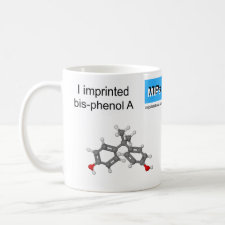
Authors: Peng YY, Chen QS
Article Title: Selective Determination of Bisphenol A Based on Molecularly Imprinted Poly(ortho-phenylenediamine) /Multi- walled Carbon Nanotubes Composite Film.
Publication date: 2016
Journal: Current Analytical Chemistry
Volume: 12
Issue: (5)
Page numbers: 431-438.
Alternative URL: http://www.ingentaconnect.com/content/ben/cac/2016/00000012/00000005/art00007
Abstract: Background: Considering that BPA has emerged as a major public health issue, there is an urgent need to establish a simple, effective, and highly sensitive method for monitoring the levels of BPA. The aim of this work was to construct an electrochemical sensor for the detection of BPA by the combination of molecularly imprinted technique and MWCNTs. The optimization of test conditions and the performance of the imprinted sensor were discussed. The application of the sensor in real water samples was evaluated. Methods: The sensor was prepared by electropolymerizing o-phenylenediamine with bisphenol A after depositing carboxylfunctionalized multi-walled carbon nanotubes onto the surface of a glassy carbon electrode. The template can be quickly removed in methanol-acetic acid (1:1, v/v) solution. The formation of PoPD film was monitored by FT-IR spectra. The morphological structures of the modified electrodes were tested by SEM. K3[Fe(CN)6] served as an electrochemical probe in this work. Cyclic voltammetry and linear sweep voltammetry were employed for the electrochemical characterization of the sensor. Results: The molecularly imprinted polymer based sensor displayed an excellent recognition capacity toward BPA compared with other structurally similar molecules, and the existence of some inorganic ions and organic compounds has no obvious effect on the determination of the analyte. Additionally, the decrease of the peak current of K3Fe(CN)6 was proportional to the BPA concentration in the range of 4.0 x 10-7 to 8 .0 x 10-5 mol L-1 with a limit of detection of 6.0 x 10-8 mol L-1. The prepared sensor also showed stable repeatability. The results in real samples obtained by the proposed method agreed with those obtained from high performance capillary electrophoresis method. Conclusion: An electrochemical sensor for BPA based on electropolymerization of the oPD in the presence of BPA on the MGCE has been successfully fabricated. When the resulting sensor was applied to the determination of BPA, it presented high sensitivity, stability and selectivity. In addition, the fabrication procedure was quite simple. The use of MWCNTs enhanced the sensitivity of detection and resulted in a better LOD; in combination with the specific selectivity of the molecularly imprinting technique, the proposed sensor provided a bright potential for the determination of BPA in practical samples
Template and target information: bisphenol A, BPA
Author keywords: bisphenol A, electropolymerization, molecularly imprinted polymer, Multi-walled carbon nanotubes, Poly-o-phenylenediamine



Join the Society for Molecular Imprinting

New items RSS feed
Sign-up for e-mail updates:
Choose between receiving an occasional newsletter or more frequent e-mail alerts.
Click here to go to the sign-up page.
Is your name elemental or peptidic? Enter your name and find out by clicking either of the buttons below!
Other products you may like:
 MIPdatabase
MIPdatabase









